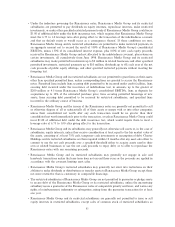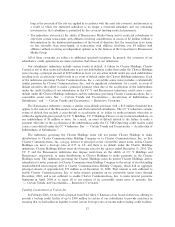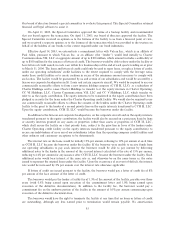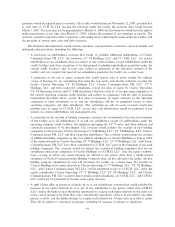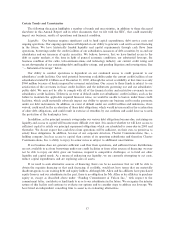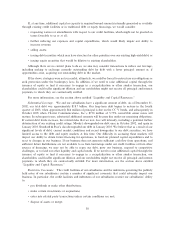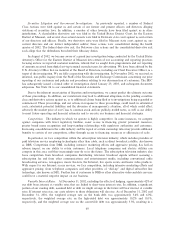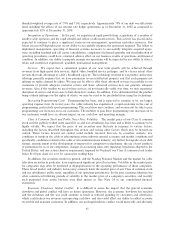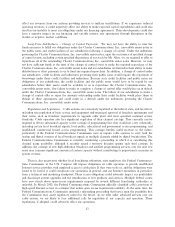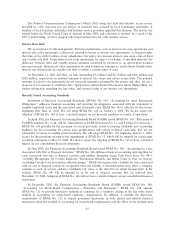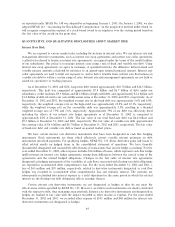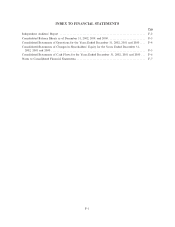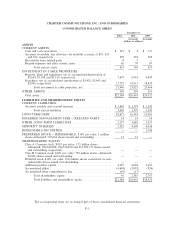Charter 2002 Annual Report Download - page 62
Download and view the complete annual report
Please find page 62 of the 2002 Charter annual report below. You can navigate through the pages in the report by either clicking on the pages listed below, or by using the keyword search tool below to find specific information within the annual report.Securities Litigation and Government Investigations. As previously reported, a number of Federal
Class Actions were Ñled against us and certain of our former and present oÇcers and directors alleging
violations of securities laws. In addition, a number of other lawsuits have been Ñled against us in other
jurisdictions. A shareholders derivative suit was Ñled in the United States District Court for the Eastern
District of Missouri, and several class action lawsuits were Ñled in Delaware state court against us and certain
of our directors and oÇcers. Finally, two derivative suits were Ñled in Missouri state court against us, our
current directors and our former independent auditor; these actions were consolidated during the fourth
quarter of 2002. The federal derivative suit, the Delaware class actions and the consolidated derivative suit
each allege that the defendants breached their Ñduciary duties.
In August of 2002, we became aware of a grand jury investigation being conducted by the United States
Attorney's OÇce for the Eastern District of Missouri into certain of our accounting and reporting practices
focusing on how we reported customer numbers, refunds that we sought from programmers and our reporting
of amounts received from digital set-top terminal manufacturers for advertising. We have been advised by the
U.S. Attorney's OÇce that no member of the Board of Directors, including our Chief Executive OÇcer, is a
target of the investigation. We are fully cooperating with the investigation. In November 2002, we received an
informal, non-public inquiry from the StaÅ of the Securities and Exchange Commission concerning our prior
reporting of our customers and policies and procedures relating to our disconnection of customers. The SEC
has subsequently issued a formal order of investigation dated January 23, 2003, and subsequent document
subpoenas. See Note 24 to our consolidated Ñnancial statements.
Due to the inherent uncertainties of litigation and investigations, we cannot predict the ultimate outcome
of these proceedings. In addition, our restatement may lead to additional allegations in the pending securities
class and derivative actions against us, or to additional claims being Ñled or to investigations being expanded or
commenced. These proceedings, and our actions in response to these proceedings, could result in substantial
costs, substantial potential liabilities and the diversion of management's attention, all of which could aÅect
adversely the market price of our Class A common stock and our publicly-traded notes, as well as our ability
to meet future operating and Ñnancial estimates and to execute our business and Ñnancial strategies.
Competition. The industry in which we operate is highly competitive. In some instances, we compete
against companies with fewer regulatory burdens, easier access to Ñnancing, greater personnel resources,
greater brand name recognition and long-standing relationships with regulatory authorities and customers.
Increasing consolidation in the cable industry and the repeal of certain ownership rules may provide additional
beneÑts to certain of our competitors, either through access to Ñnancing, resources or eÇciencies of scale.
In particular, we face competition within the subscription television industry, which includes providers of
paid television service employing technologies other than cable, such as direct broadcast satellite, also known
as DBS. Competition from DBS, including intensive marketing eÅorts and aggressive pricing, has had an
adverse impact on our ability to retain customers. Local telephone companies and electric utilities can
compete in this area, and they increasingly may do so in the future. The subscription television industry also
faces competition from broadcast companies distributing television broadcast signals without assessing a
subscription fee and from other communications and entertainment media, including conventional radio
broadcasting services, newspapers, movie theaters, the Internet, live sports events and home video products.
With respect to our Internet access services, we face competition, including intensive marketing eÅorts and
aggressive pricing, from telephone companies and other providers of ""dial-up'' and digital subscriber line
technology, also known as DSL. Further loss of customers to DBS or other alternative video and data services
could have a material negative impact on our business.
Variable Interest Rates. At December 31, 2002, excluding the eÅects of hedging, approximately 42% of
our debt bears interest at variable rates that are linked to short-term interest rates. In addition, a signiÑcant
portion of our existing debt, assumed debt or debt we might arrange in the future will bear interest at variable
rates. If interest rates rise, our costs relative to those obligations will also rise. As of December 31, 2002 and
December 31, 2001, the weighted average rate on the bank debt was approximately 5.6% and 6.0%,
respectively, the weighted average rate on the high-yield debt was approximately 10.2% and 10.1%,
respectively, and the weighted average rate on the convertible debt was approximately 5.3%, resulting in a
60



